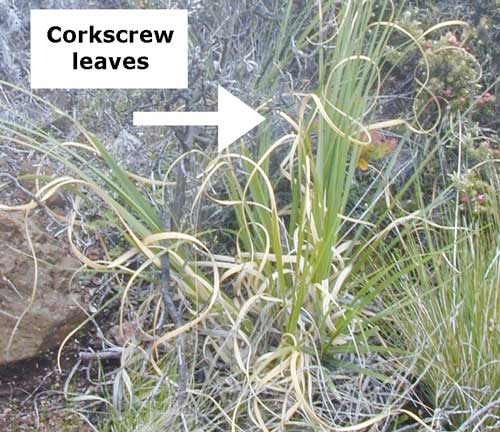Pampas Grass
Pampas grass (Cortaderia jubata, Cortaderia selloana)
 Hawai‘i-Pacific Weed Risk Assessment Score: C. jubata – 26 High Risk. C. selloana – 24 High Risk. Visit Plant Pono for more information.
Hawai‘i-Pacific Weed Risk Assessment Score: C. jubata – 26 High Risk. C. selloana – 24 High Risk. Visit Plant Pono for more information.
Weed Fire Risk Score = 0.72 (These species are likely a high fire risk in Hawai’i); Visit https://pacificfireexchange.org/weed-fire-risk-assessments/ for more information
Regulatory Status: Hawaii Noxious Weed (HAR 68)
Prevention and Control Category: KISC Target Species. OISC Target Species. MISC Target Species. BIISC Target Species
Description
Pampas grass is an erect giant bunch grass with long, slender, bright green, saw-toothed
leaves. At its base are dried, corkscrew-shaped leaves. It has large showy flower plumes that extend 2-3′ beyond the foliage. Two species of pampas grass are found in Hawaii, Cortaderia selloana and C. jubata, which are difficult to tell apart. Both reach heights of 9-10′ and have loosely clumped pinkish-white seed heads. They flower from July through November. Spent flower stalks are sometimes persistent for several years
Impacts
Pampas grass grows rapidly, produces thousands of seeds per flower plume, and can accumulate large amounts of fire prone biomass. Seeds are viable for 4-6 months, but field evidence from Hawaii suggests viability could be greater. It can crowd out native species, impede access, degrade grazing lands, and create fire hazards.
Distribution
Native to South America, pampas grass was introduced to Hawaii as an ornamental. On Maui, this plant has escaped cultivation and spread into pristine, upland native forests. It is found in pastures, gulches, yards, along road cuts. Cortaderia are found in residential and remote areas of Maui and Oʻahu.
What you can do
It is important NOT to pull and move the plant, as proper removal and disposal are essential to prevent spreading seeds and re-sprouting.
Look-alike Species
Sugarcane (Saccharum officinarum): is a Polynesian introduced plant that has a similar seed plume as pampas but the plume is not as dense and sugarcane does not have corkscrew leaves.
Native Hawaiian sedges (Cyperaceae sp.): These can be confused with young pampas grass. They do not produce corkscrew leaves, tall flowering stalks, or large showy seed plumes. Most Hawaiian sedge leaves are not as sharp.
For more information, see:
- Invasive Grasses in Hawaiʻi and their impacts
- Cortaderia selloana Datasheet from CABI
- Cortaderia jubata Datasheet from CABI
- Cortaderia jubata information from HEAR
- Cortaderia selloana information from HEAR
- Cortaderia jubata information from ISSG
- Cortaderia selloana information from ISSG
- Pampas grass information from UC WRIC
- The Hawai‘i Invasive Species Council, https://dlnr.hawaii.gov/hisc/info/species/pampas-grass/
- Maui Invasive Species Committee, mauiinvasive.org/2013/02/24/pampas-grass/
- Oʻahu Invasive Species Committee:www.oahuisc.org/pampas-grass/
- Kauaʻi Invasive Species Committee,www.kauaiisc.org/pampas-grass/
- Big Island Invasive Species Committee, https://www.biisc.org/wp-content/uploads/Pampas-grass_final.pdf
- CTAHR Weed’s of Hawaii’s Pastures and Natural Areas: https://www.ctahr.hawaii.edu/invweed/WeedsHI/W_Cortaderia_jubata.pdf
